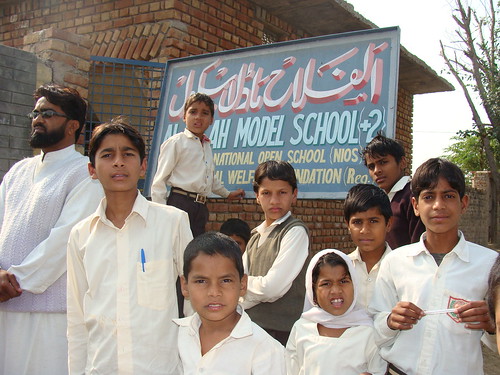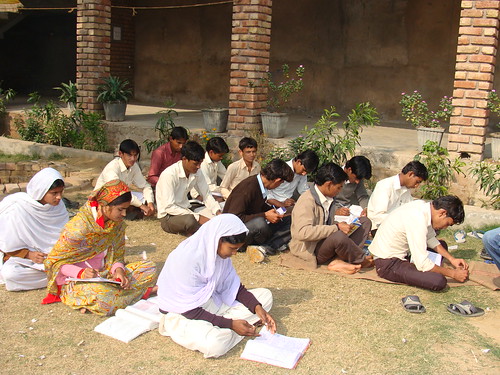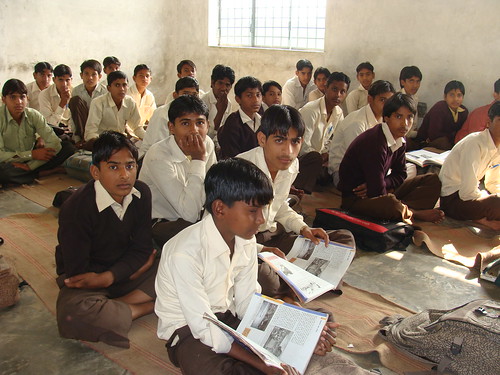By Yoginder Sikand, TwoCircles.net
After Ayodhya, Malda and Murshidabad and Deoband TwoCirces.net is now brining out a series on socio-economic and educational condition of Muslim-dominated Mewat in Haryana. Meos (or Muslims) are traditionally a strong community but for some reasons they have been most backward community in North India in education and economic development. Though still backward economically, Meos have begun to break self-imposed shackles as they are coming out of their home to learn. A sort of educational revolution is seen today in Mewat. The first few parts of our special series on Mewat will take you deep in the area to let you see what’s happening there in the field of education — Editor
Lying to the immediate south of Delhi, straddling the rocky outcrops of the Aravalli range, is the region known as Mewat, named after the Meo Muslims, the principal community living in the area. Mewat covers large parts of the Gurgaon and Faridabad districts in Haryana and Alwar and Bharatpur in Rajasthan. Recently, a separate district was carved out of the Meo-dominated parts of Haryana and also given the name of ‘Mewat’.
Two decades ago I used to regularly visit Mewat—for my Ph.D. dissertation, which was about the history of the global Islamic revivalist Tablighi Jamaat, now the world’s largest such movement, which had its roots in the humble hamlets of Mewat in the 1920s. It was the Tablighi Jamaat that put Mewat on the map of the world. Some months ago, I returned to Mewat, after a gap of fifteen years, curious to learn how much, if at all, the region had changed in this period.
Despite its proximity to Delhi, Gurgaon and Jaipur, Mewat is one of the most impoverished regions in northern India. When I did fieldwork in the region in the 1990s, the literacy rate among the Meos, more than a million-strong community, was estimated at less than 10 per cent, and that of Meo females at lower than 5 per cent. This was attributed to extreme poverty (most Meos being small peasants) as well as the influence of the ultra-conservative Tablighi Jamaat, which was seen as being opposed to education imparted in regular schools, particularly for girls, believing that this would lead the Meos astray from Islam.

Two decades later, the Mewat is still characterized by endemic poverty. The villages and towns I visited this time seem to have hardly changed in terms of looks since I saw them last. But for a couple of recently-constructed large, brightly-painted mansions and a few new shops (only a few of which were Meo-owned), Nuh and Ferozepur-Jhirka, the two largest towns in Mewat, seemed to be no different from what I remembered of them from my earlier visits. In fact, they only seemed to have become even more filthy and chaotic. The villages I travelled to seemed to have remained frozen in time—the same squalid mud huts, the same visible signs of neglect by the state, the same scene of Meo women labouring in the fields while their menfolk squatted on cots sunning themselves or sucking away at their hukkahs at roadside eateries. But one change struck me forcefully throughout my trip: a distinct thirst on the part of many younger Meos for ‘modern’ education—nothing short of a revolution in terms of demands, hopes, and expectations.
Meos breaking shackles to get education
This was quite in contrast to what I had witnessed on my first visit to Mewat, in the late 1980s, when there was not a single Meo-run school, when there were hardly a dozen or so Meo girls in government-run schools throughout the region, and when many local ulema or Muslim clerics, mostly affiliated to the Tablighi Jamaat, openly condemned ‘modern’ schools as dens of irreligiousness and licentiousness, insisting that the Meos should send their children only to madrasas instead. Today, however, literally dozens of ‘modern’ schools run by Meos have mushroomed all over Mewat; girls are enrolling in these and in government-run schools in rapidly increasing numbers; many ulema are in the forefront of promoting ‘modern’, in addition to religious, education among the Meos; and scores of madrasas have begun teaching English and Hindi, with some of them having actually transformed themselves into regular schools.
Located on the outskirts of Ferozepur Jhirka town is the sprawling 15-acre campus of the recently-established English-medium Aravalli Public School, the largest Meo-run school in Mewat. Founded by a retired Meo engineer, Muhammad Israil, this residential school has some 600 students on its rolls, 60% of whom are Meos, and roughly 10% Muslims from other parts of India, the rest being from other religious communities. 60 of the school’s 70 girl students are Meos. The costs of studying here are exorbitant by average Meo standards, but tuition fees are waved for girls in order to encourage more Meo girls, whose overall literacy rate is less than 15%, to enroll. The schools’ principal is a Hindu. Most teachers are non-Meos, including Muslims from other parts of India as well as non-Muslims from Mewat.
The school’s well-maintained campus is lined with fine buildings built around a vast playing field. The swank technical training institute was built with aid from the Japanese Embassy, so I am informed by a student who takes me around, and the girls’ hostel building that is still under construction is being financed by the Islamic Development Bank.
It is late in the afternoon, and the students pour out of their hostels and onto the playing field, forming teams to play football and cricket. They are dressed in jeans or shorts, and brightly-coloured T-shirts or jackets and sneakers. None of them sports the almost mandatory Tablighi-style beard that almost every Meo male in their fathers’ generation does. These students are nearly all Meos—I can hardly believe that at first, for hardly any Meo boys dressed like this when I last visited the area. A dozen girls, Meos all, take a sprint around the playing field, brandishing their badminton rackets. Needless to say, that would have been considered sheer anathema two decades ago.
I stare, dumbstruck, at the students, stunned at what I see before me. When I first visited Mewat, the parents of most of these students would almost all have been un-educated peasants—their fathers dressed in long kurtas, tahmats and ponderous turbans, their mothers, wholly illiterate, kept carefully cloistered in their homes when they were not compelled to work in the fields.

That a major section of Meo youths are today defying deep-rooted traditions by clamoring for ‘modern’ education is undeniable, and signs of this are today visible all over. I am not sure if this is an entirely positive development, though. Need ‘modernisation’ necessarily be equated with ‘Westernisation’? Does it have to also necessarily imply ‘secularisation’, in the sense of focusing wholly on worldly knowledge and ‘success’, consequently trivializing religion and moral values? These crucial questions are being raised by many Meos themselves, who fear that the irrepressible desire on the part of Meo youths for ‘modern’ education might seriously erode traditional, religious values and promote crass consumerism. This is summed up in a complaint of a maulvi attached to a Deobandi madrasa located adjacent to the Aravalli Public School—‘The school has no facility for teaching Islamic Studies. All that they are taught is about this world (duniya)—how to gather more information and degrees so that they can get highly-paid jobs and lead a life of ease and comfort.’
Schools imparting religious and secular education
Devising an educational system that balances the needs of the duniya and the deen or religion has been a longstanding concern for Muslim educationists. When I first visited Mewat, I came across almost ulema who were supportive of, leave alone actively engaged in, promoting ‘modern’ or ‘secular’, in addition to religious, education. In contrast, on this trip, I met with numerous maulvis, all graduates of what are commonly considered to be ‘orthodox’ madrasas, who have set up their own schools that impart a healthy mix of both sorts of learning.
One of these ulema is an old friend of mine, 33 year-old Qari Sirajuddin of Bhadas village near the town of Nuh. The last time I met him was when he was 18 years old. He had just completed his religious education at the Jamia Sanabil, an Ahl-e Hadith madrasa in Delhi, and had returned to his village, where he had started a small maktab in a two-room tenement to provide basic Islamic education to girls. Today, what started off as the Madrasat ul-Banat Ayesha Siddiqa is now the Al-Falah Model Senior Secondary School. Affiliated to the Haryana Educational Board, it provides education till the twelfth standard. It has almost 700 students on its rolls, of whom almost a hundred are non-Muslims. Girl students number some 125, of whom 25 are Hindus, and the rest Meo Muslims. The school supplements the government-approved syllabus for modern subjects with compulsory Islamic Studies, Urdu and Arabic for Muslim students and Sanskrit, for Hindu students.

What, I ask Qari Sirajuddin, made him transform what began as a girls’ madrasa into a co-educational secondary school? ‘There are scores of madrasas in Mewat’, he answers, ‘but what we lack are sufficient general schools, for which there is now increasing demand’. Further, he adds, ‘I did not want to keep depending on people for donations (chanda), which I would have had to had I continued to run it as a madrasa. As a school it can generate funds for itself through the fees that it charges’.
Several other small madrasas across Mewat might, too, like to make the shift and become regular schools, albeit with provision for Islamic education for their Muslim students, Qari Sirajuddin tells me. However, a major hurdle in this regard are the government’s stringent norms for providing recognition to private schools that most such madrasas fail to meet. As per the existing rules, to qualify for official recognition an institution must possess a basic minimum plot of land (half acre for primary schools, one and a half acres for middle schools and two acres for high schools)—which effectively rules out most madrasas. Likewise, an institution must possess a certain number of rooms of a particular size, a library with a basic specified number of books and so on, which many smaller madrasas, that run small budgets based on donations, simply cannot afford. Were the government to lower these requirements in the case of madrasas, Qari Sirajuddin suggests, several small madrasas in Mewat might well transform themselves into regular schools. ‘That’, he says, ‘would be a much less expensive and controversy-free way to modernize madrasas.’
Qari Sirajuddin’s own family, whom he introduces me to over a hearty meal at his home, exemplifies the rapid transformation that the Meos are today undergoing in terms of their approach to education. Although himself a madrasa graduate, none of his children is training to become a traditional alim or Islamic scholar. The first two of his six children, including one girl, study in modern, privately-run ‘public’ schools, and the rest in his own school. His brother, also a graduate of a traditional Ahl-e Hadith madrasa (the Madrasa Riyaz ul-Ulum, Delhi) has just finished a degree in Social Work from the Jamia Millia Islamia and hopes to join the civil services.

His support for ‘modern’, in addition to religious, education, Qari Sirajuddin assures me, is something that he shares with increasing numbers of ulema today—not just in Mewat, but across other parts of India, too. ‘Even some very conservative Deobandi Meo ulema, who traditionally frowned on modern schools, have opened such institutions, fearful that otherwise Muslim children would study in non-Muslim schools, because of which they might, as they see it, go astray’, he tells me. Madrasas throughout Mewat, he says, have now introduced basic English, Hindi and Mathematics in their curriculum, mainly because they realize that this is what parents of most Meo children now also want. At the same time, he laments, few of these madrasas take the teaching of these subjects seriously. ‘Some of them claim to be teaching English and other such subjects simply to keep the mouths of their critics shut and to stave off criticism that they are not giving their students a well-rounded education’, he says. ‘The managers of most madrasas do not know English or other modern subjects themselves, and so are not in a position to prescribe a proper syllabus for these subjects and to supervise the teachers they appoint for teaching them.’ Many of them also feel, Qari Sirajuddin goes on, that if they were to deviate from the traditional Deobandi-style curriculum by giving more than just a basic attention to modern subjects they would be criticized by their religious ‘elders’. Typically, he says, the staff they employ for teaching these subjects are simple high school graduates, with no training at all, and with a very poor command of these subjects.
Be that as it may, the very fact that Mewat’s madrasas, once known for their visceral opposition to what they saw as the baneful influence of ‘Western-style’ education imparted in schools, are increasingly willing to incorporate these ‘Western’ subjects into their curriculum is ample proof, Qari Sirajuddin assures me, of the veritable revolution in the demands and expectations of vast numbers of Meo parents as regards the education of their children.
Qari Sirajuddin can be contacted on 09813790027 or at [email protected]
(Photos and interviews taken by Mumtaz Alam Falahi of TwoCircles.net)

